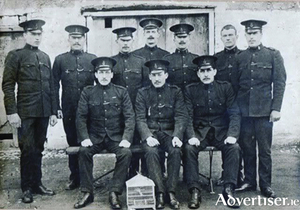Search Results for 'George Nicholls'
9 results found.
Murder in the city, intimidation in the county - Galway, May 1921
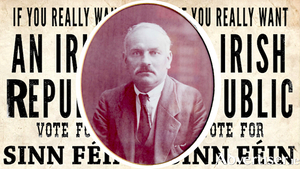
The Government of Ireland Act came into being on May 3 1921, resulting in a parliament for the six northern counties and devolved powers for the 26 counties.
The Galway Volunteers

Just a few weeks after the Irish Volunteers were formed in Dublin, a meeting was set up in the Town Hall on December 12th, 1913 to establish a Volunteer force in Galway. There was a lot of excitement and expectation as Eoin McNeill, Roger Casement and Pádraic Pearse told the packed hall that their main objective was to win Home Rule but the movement was also formed to protect them from the Ulster Volunteers. The meeting, which was chaired by George Nicholls, was a major success and some 600 men joined up that evening.
Galway in the weeks leading up to the Rising
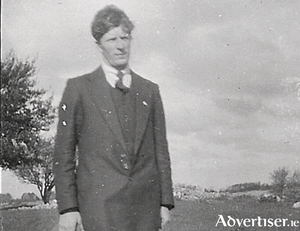
On Tuesday 25 April 1916, Galway became the only county outside of Leinster to take up arms against the British state during the Easter Rising. In fact, only three parts of provincial Ireland participated in the Rising: Enniscorthy in county Wexford; Ashbourne in north county Dublin; and county Galway, where several hundred rebels took over 600 square miles of the east of the county between Tuesday 25 April and Saturday 29 April. Commemorative documentaries and history books pay little attention to the Galway Rising with the focus tending to be on the more dramatic events that took place in Dublin, but Galway’s Rising was an important part of the story of the Easter Rising; and the story of the hundreds of brave Galway men who stood up to the British Empire in April 1916 deserves to be told in detail. In this series of five articles, FERGUS CAMPBELL will explain why Galway rose when so many other parts of provincial Ireland did not, and he will also tell the story of what happened in Galway during the Rising, and the impact that the Rising had on Galway society. This account is based on many documents, police reports, newspaper accounts and memoirs but most of the quotations are derived from the witness statements that Galway rebels made to the Bureau of Military History during the 1940s and 1950s, and these can be read online.
St Patrick’s Day parade in Galway, 1916
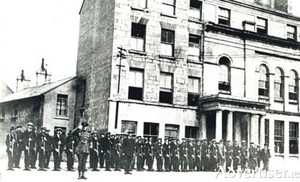
This parade started from the Square in the following order: Eyre Square North – Industrial School Band; Galway Urban District Council; Galway Board of Guardians; Students of UCG; AOH. Eyre Square East – The Monastery School Fife and Drum Band; UIL; Town Tenant’s League; Galway Woollen Manufacturing Co; and the Irish National Foresters.
Republican prisoners in the Town Hall
This remarkable photograph was taken in 1920/21. It shows a group of republican prisoners who are being held in the Town Hall. They are surrounded by barbed wire and are being carefully watched by a soldier you can see standing beside the tin hut. He is wearing a ‘Brodie’ helmet which was a steel combat helmet invented by Englishman John Brodie during World War I. There were probably more soldiers on duty inside the hut watching the detainees, the photographer, and anyone else who might have been was passing. A notice on one of the windows reads “No one is allowed within ten yards of this building.”
Seamus Carter, athlete, Gaeilgóir, patriot
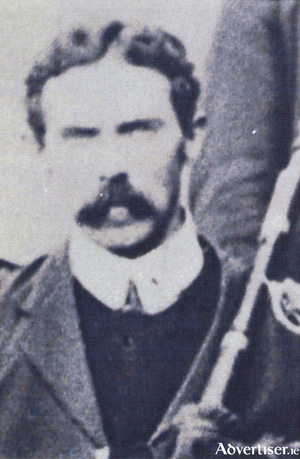
Seamus Carter was a fluent Irish speaker who was a member of the Gaelic League since its inception. He was the secretary of the Oireachtas when it was held in Galway in 1913, the famous photograph of which hangs in the Town Hall.
‘The Galway Resolution’ - An attempted coup by some county councillors
On December 3 1920, at the height of the War of Independence, quite an extraordinary event happened in Galway County Council. It passed a resolution, known as ‘The Galway Resolution’, repudiating the authority of the newly established Dáil; it rescinded the resolution for the collection of rates, (which were collected locally, and passed on to Dáil Éireann, and not to the British authorities), and incredibly, Galway County Council now offered its offices to negotiate peace, directly with the British prime minister, David Lloyd George.
George Nicholls, Rising organiser and volunteer
George Nicholls was a young solicitor who worked in G.C. Conroy’s office in Francis Street. In 1912, he set up a pipe band known as “Cumann Píobairí naGaillimhe”, the only band with an Irish language name to play at O’Donovan Rossa’s funeral to which they travelled in the company of Padraic Pearse.
